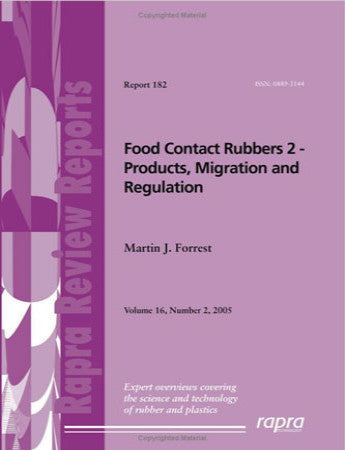Toxicity and Safe Handling of Rubber Chemicals, Fourth Edition


Toxicity and Safe Handling of Rubber Chemicals, Fourth Edition
Author: Rapra Technology and BRMA
ISBN 978-1-85957-174-3
ISBN 978-1-85957-174-3
Published: 1999
Pages 380, Spiral-bound
$310.00
‘Reliable and authoritative information on the risks associated with the handling and use of chemicals is a prerequisite for their proper control and for preventing risks to health and safety…..To have this key information assembled in a readily accessible and user-friendly form is a considerable bonus, and in publishing this much-revised version of their Code of Practice, the BRMA has performed a valuable service for all the people, managers and workers alike, who earn their livelihoods in the rubber industry.’ - Andrew Porter, Chairman of the Rubber Industry Advisory Committee.
This reference book provides an essential guide to health and safety in the rubber processing industry. The British Rubber Manufacturers’ Association and Rapra Technology Limited have combined forces to update the information on hundreds of different rubber chemicals. New data has been compiled from reputable manufacturers and suppliers, and from standard sources of health and safety data. The book includes an introduction to the regulations governing the labeling and use of chemicals, together with definitions of toxicity, carcinogenicity, mutagenicity, and effects on reproduction. Specific hazard, risk, and safety labels are explained. The issue of health surveillance in the industry is dealt with in detail.
Many rubber chemicals are examined individually in the form of abbreviated safety data sheets. They are listed under categories of use: reinforcing agents and fillers, accelerators and retarders, vulcanising agents, antidegradants, organic peroxides, peptisers and processing aids, ester plasticisers, blowing agents, bonding agents, latex auxiliaries, pigments and miscellaneous. Each chemical has a data sheet including trade names, suppliers, physical data, fire hazards (including explosion risk), regulatory labeling, health hazards, emergency first aid, and food contact listings (FDA and BgVV). New to this edition is the addition of CAS and EINECS numbers to aid identification of materials.
Other rubber chemicals are discussed as groups: natural and synthetic polymers, process oils and chlorinated waxes, tackifying and reinforcing resins, and rubber solvents. In the section on process oils, there is a discussion on the introduction of new synthetic oils, with reduced aromatic content.
Environmental control is a key issue in today’s world. This book devotes a chapter to the subject of dust and vapour emissions during rubber processing and methods of monitoring. The section on dust includes the latest guidelines, definitions, and significance of respirable and inhalable fractions. There are details of monitoring exposure to mixtures of hydrocarbon solvents, and also of measuring specific vapours (more than thirty different chemicals are listed separately).
A bibliography is provided for those who wish to study a particular subject in depth. This lists standard toxicology reference books, epidemiological case studies from the rubber industry, and useful publications from the Health and Safety Executive (including the Rubber Industry Advisory Committee, RUBIAC).
This reference book provides an essential guide to health and safety in the rubber processing industry. The British Rubber Manufacturers’ Association and Rapra Technology Limited have combined forces to update the information on hundreds of different rubber chemicals. New data has been compiled from reputable manufacturers and suppliers, and from standard sources of health and safety data. The book includes an introduction to the regulations governing the labeling and use of chemicals, together with definitions of toxicity, carcinogenicity, mutagenicity, and effects on reproduction. Specific hazard, risk, and safety labels are explained. The issue of health surveillance in the industry is dealt with in detail.
Many rubber chemicals are examined individually in the form of abbreviated safety data sheets. They are listed under categories of use: reinforcing agents and fillers, accelerators and retarders, vulcanising agents, antidegradants, organic peroxides, peptisers and processing aids, ester plasticisers, blowing agents, bonding agents, latex auxiliaries, pigments and miscellaneous. Each chemical has a data sheet including trade names, suppliers, physical data, fire hazards (including explosion risk), regulatory labeling, health hazards, emergency first aid, and food contact listings (FDA and BgVV). New to this edition is the addition of CAS and EINECS numbers to aid identification of materials.
Other rubber chemicals are discussed as groups: natural and synthetic polymers, process oils and chlorinated waxes, tackifying and reinforcing resins, and rubber solvents. In the section on process oils, there is a discussion on the introduction of new synthetic oils, with reduced aromatic content.
Environmental control is a key issue in today’s world. This book devotes a chapter to the subject of dust and vapour emissions during rubber processing and methods of monitoring. The section on dust includes the latest guidelines, definitions, and significance of respirable and inhalable fractions. There are details of monitoring exposure to mixtures of hydrocarbon solvents, and also of measuring specific vapours (more than thirty different chemicals are listed separately).
A bibliography is provided for those who wish to study a particular subject in depth. This lists standard toxicology reference books, epidemiological case studies from the rubber industry, and useful publications from the Health and Safety Executive (including the Rubber Industry Advisory Committee, RUBIAC).


